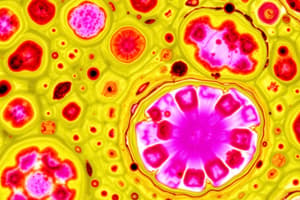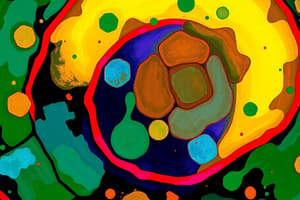Podcast
Questions and Answers
What does the classification of tissues primarily depend on?
What does the classification of tissues primarily depend on?
- Their color and size
- The location within the organism
- The age of the organism
- Their structure and function (correct)
Which of the following is NOT a function of epithelial tissue?
Which of the following is NOT a function of epithelial tissue?
- Secretion
- Protection
- Filtration
- Electrical conductivity (correct)
What is a key characteristic of epithelial tissue?
What is a key characteristic of epithelial tissue?
- It has polarity with apical and basal surfaces (correct)
- It contains a lot of extracellular matrix
- It primarily stores fat and energy
- It is highly vascularized
How are tissues organized within multicellular organisms?
How are tissues organized within multicellular organisms?
Which type of tissue is primarily responsible for absorption?
Which type of tissue is primarily responsible for absorption?
What is the term used to describe groups of cells with similar structure and functions?
What is the term used to describe groups of cells with similar structure and functions?
Which of the following statements about connective tissue is correct?
Which of the following statements about connective tissue is correct?
Which level of biological organization is directly above tissue?
Which level of biological organization is directly above tissue?
What type of collagen is primarily found in reticular connective tissue?
What type of collagen is primarily found in reticular connective tissue?
Which type of specialized connective tissue is known for providing strength with flexibility?
Which type of specialized connective tissue is known for providing strength with flexibility?
Which type of muscle tissue is characterized by involuntary control and striations?
Which type of muscle tissue is characterized by involuntary control and striations?
What is the primary function of blood in the body?
What is the primary function of blood in the body?
Where is fibrocartilage predominantly found?
Where is fibrocartilage predominantly found?
Which type of connective tissue serves as a storehouse for nutrients and is packed with blood vessels?
Which type of connective tissue serves as a storehouse for nutrients and is packed with blood vessels?
What is the main role of smooth muscle tissue in the body?
What is the main role of smooth muscle tissue in the body?
Which type of cartilage provides a definite but pliable form and is found in structures like the larynx?
Which type of cartilage provides a definite but pliable form and is found in structures like the larynx?
What is the primary function of axons in neurons?
What is the primary function of axons in neurons?
Which type of neuron is responsible for carrying information from the body to the central nervous system (CNS)?
Which type of neuron is responsible for carrying information from the body to the central nervous system (CNS)?
What type of meristematic tissue is responsible for increasing the length of roots and stems?
What type of meristematic tissue is responsible for increasing the length of roots and stems?
Which of the following types of permanent tissue is characterized by the ability to conduct substances?
Which of the following types of permanent tissue is characterized by the ability to conduct substances?
Which statement accurately describes non-meristematic permanent tissues?
Which statement accurately describes non-meristematic permanent tissues?
What characterizes simple squamous epithelium?
What characterizes simple squamous epithelium?
Which type of connective tissue provides strength in multiple directions?
Which type of connective tissue provides strength in multiple directions?
What is a defining feature of transitional epithelium?
What is a defining feature of transitional epithelium?
Which connective tissue type is primarily made up of type I collagen?
Which connective tissue type is primarily made up of type I collagen?
Which type of epithelium appears to have multiple layers but is actually a single layer of varying cell height?
Which type of epithelium appears to have multiple layers but is actually a single layer of varying cell height?
Which characteristic does NOT apply to connective tissue?
Which characteristic does NOT apply to connective tissue?
What is the primary function of epithelial tissue?
What is the primary function of epithelial tissue?
In epithelial classification, which term describes cells that are taller than they are wide?
In epithelial classification, which term describes cells that are taller than they are wide?
Flashcards are hidden until you start studying
Study Notes
Levels of Biological Organization
- The levels of biological organization from smallest to largest are: cell, tissue, organ, organ system, organism, population, community, ecosystem, and biosphere.
Structure vs Function
- Structure determines function, which means the way a part is made and arranged dictates its job.
- Example: the structure of a bird's wing allows for flight, while the structure of a fish's fin allows for swimming.
Tissue
- Tissue is a group of similar cells with a common structure and function.
- Different types of tissue have different structures that are specialized for their function.
Animal Tissues
- Animals have four types of tissues: epithelial, connective, muscle, and nervous.
Epithelial Tissue
- Epithelium is a sheet of cells that covers body surfaces or lines body cavities.
- Functions include protection, absorption, filtration, and secretion.
- Characteristics include polarity, specialized contacts, support by connective tissue, avascularity (lack of blood vessels), and innervation (presence of nerve fibers).
Classification of Epithelium
- Classified based on the number of cell layers and the shape of the cells.
- Number of Layers:
- Simple: one layer of cells.
- Stratified: two or more layers of cells.
- Pseudostratified: a single layer of cells that appears to be multiple layers due to varying cell heights and nuclear positions.
- Transitional: cells that can change shape and slide across each other, allowing stretching.
- Shape of Cells:
- Squamous: flat, thin, scale-like cells.
- Cuboidal: cube-shaped cells with roughly equal height and width.
- Columnar: tall, rectangular, or column-shaped cells, taller than they are wide.
Connective Tissue
- Connective tissue supports, binds, and protects other tissues and organs.
- Functions include providing strength, storing nutrients, and forming organ capsules.
- Generally vascular (has a rich blood supply) but not always.
Types of Connective Tissues
- Collagenous Connective Tissue:
- Predominantly made up of type I collagen.
- Classified into:
- Loose Connective Tissue:
- Areolar Connective Tissue: cushions organs, has loosely arranged cells and fibers.
- Dense Regular Connective Tissue: found in tendons and ligaments, has regularly arranged collagen bundles for strength in one direction.
- Dense Irregular Connective Tissue: found in skin and organ capsules, has irregularly arranged collagen bundles for strength in all directions.
- Loose Connective Tissue:
- Reticular Connective Tissue:
- Formed by type III collagen.
- Internal supporting framework of some organs, has a delicate network of fibers and cells.
- Adipose Tissue: stores nutrients, packed with cells and blood vessels.
- Elastic Connective Tissue:
- Formed by type II collagen, a component of joint cartilage.
- Found in bronchi, trachea, blood vessels, and hollow organs, provides flexibility and rebound.
Specialized Connective Tissue
- Cartilage:
- Provides strength, flexibility, and resistance to wear.
- Found in epiglottis, external ear, larynx, intervertebral discs, and joint capsules.
- Types:
- Hyaline Cartilage: found on the ventral ends of ribs, in the larynx, trachea, bronchi, and on articulating surfaces of bones, provides a definite but pliable form.
- Elastic Cartilage: found in the epiglottis and external ear flaps, provides great flexibility.
- Fibrocartilage: found in intervertebral discs and at ligament/tendon insertions, is tough and strong.
- Bone Tissue (Osseous Tissue):
- Provides framework, strength, allows movement, stores calcium, and contains blood-forming cells.
- Blood:
- Transports oxygen, carbon dioxide, and nutrients, and plays a role in the immune response.
Muscle Tissue
- Responsible for body movement, moving blood, food, and waste through organs, and mechanical digestion.
Types of Muscle Tissue
- Smooth Muscle:
- Found in organ walls and blood vessels, involuntary, spindle-shaped cells that push substances through organs.
- Skeletal Muscle:
- Large body muscles, voluntary, striated muscle packed in bundles and attached to bones for movement.
- Cardiac Muscle:
- Found in the heart wall, involuntary, striated muscle with intercalated discs that connect cells for synchronized contractions during heartbeat.
Nervous Tissue
- Conducts impulses to and from body organs via neurons.
- Controls all body activities.
- Composed of brain, spinal cord, and nerves.
Neuron
- Electrically excitable cells in the nervous system that process and transmit information.
- Composed of three parts:
- Cyton (Cell Body): star-shaped body containing the nucleus and cytoplasm.
- Axon: long, single part that carries messages away from the cyton.
- Dendrites: short, branched parts that carry messages towards the cyton.
Types of Neurons
- Sensory Neurons: carry information from the body's interior and environment to the central nervous system (CNS).
- Motor Neurons: carry impulses away from the CNS to effector organs.
Plant Tissues
- Plant tissues are classified as meristematic or permanent.
Meristematic Tissue
- Composed of cells with the capacity to divide.
- Immature and help plants to divide continuously.
- Types:
- Apical Meristems: found at the tips of shoots and roots, increase plant length.
- Intercalary Meristems: found at intervals along stems near nodes, increase plant length.
- Lateral Meristems: found along the sides of roots and stems, increase plant girth.
Permanent Tissue
- Derived from meristematic tissue and lack the ability to divide.
- Carry out other functions like conduction, storage, and support.
- Types:
- Simple Permanent Tissues: parenchyma, collenchyma, and sclerenchyma.
- Complex Tissues: xylem and phloem.
Studying That Suits You
Use AI to generate personalized quizzes and flashcards to suit your learning preferences.





